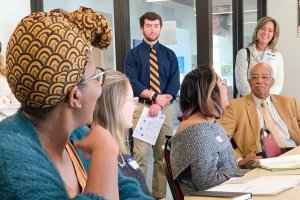Immersive learning and service: Cause Communications course takes the classroom to the community

Senior Courtney Decker’s Fall 2019 Cause Communications project didn’t come with a map.
But that’s a good thing, because charting and re-charting direction in the MEJO 490 course that paired students from the UNC Hussman School of Journalism and Media with Carrboro nonprofit CommunityWorx mimics the real-world conditions she thinks she’ll face as a media professional.
During the course, Decker — and her fellow students — discovered the details on their own, as they researched ways to help 70-year-old CommunityWorx reach “grasstop” stakeholders, groups such as elected officials and university faculty who often hold the keys to influence and funding.
CommunityWorx (formerly the PTA Thrift Shop) focuses on enriching the lives of local youth and their families, specifically those dealing with socioeconomic disparities in arenas such as education, employment and affordable housing.
“I was really able to put what I learned in the classroom to the test,” said Decker, a Greensboro native who with 34 classmates created resource guides and communications suggestions for CommunityWorx, as well as other nonprofit leaders throughout the community. The students also examined external case studies to identify effective strategies involving “grasstop” groups in other areas across the country dealing with substantial opportunity and achievement gaps.
The students’ coursework culminated with a Nov. 21, 2019, roundtable discussion called “Carolina Cultivates” at which the students presented their findings to various nonprofit leaders from across the community. Former Chapel Hill Mayor Howard N. Lee served as the event’s keynote speaker.
"The project is a strategic partnership between CommunityWorx and the UNC Hussman School of Journalism and Media. Alliances like this demonstrate that big issues, like closing opportunity gaps, require collaboration from all sectors of the community,” said Erik Valera, CommunityWorx’s chief operating officer. Valera noted the strategic importance of volunteer communications work for nonprofits as they often operated with limited communications budgets and needed creative solutions to amplify their messages.
The project enriched the students just as much, said UNC Hussman faculty member Marshéle Carter, who created and teaches the course. Carter, who has over 35 years professional experience in the nonprofit communications industry, created the course, “MEJO 490: Cause Communications: Public Relations Strategies for Nonprofit Organizations,” to give Hussman students a deep dive into nonprofit communications, as well as hands-on communications work.
Though the course features classroom instruction, the service-learning project is the key component of the course.
“In life, nobody gives us a map, you have to figure things out yourself,” Carter said. “And the students really stepped up during the course. They were definitely hands-on, and they didn’t have a lot of hand holding.”
Experiential and service-learning courses comprise an important element of Hussman’s curricular foundation, said Lois Boynton, an associate professor who teaches several courses specializing in public relations work at Hussman.
In the PR track alone, courses like “MEJO: 332 Public Relations Writing,” “MEJO: 634 Public Relations Campaigns” and a collection of FashionMash (fashion industry PR) courses allow students to “give back, learn best practices and stumble when there’s someone there to catch them,” Boynton said.
That experience of learning from mistakes in real time presents a critical part of “real-world” learning, Boynton said, because, well — that’s the real world.
“As a human being, you’re going to screw up,” Boynton said. “But it’s not the falling that’s important, it’s how you get back up.”
Carter also notes that hands-on learning compels students into dealing with “clients” face-to-face, a hugely important part of public relations work — even in today’s digital world — and one the classroom doesn’t necessarily teach.
Also, Carter hoped the relationships with clients and stakeholders students formed during the course informed their view about the complexity of the Chapel Hill and Carrboro communities, while representing UNC as a resource for all the community’s residents.
“I think the whole service-learning aspect that Hussman has embraced is so beneficial to the school,” Carter said. “It really fosters community and good will between town and gown.”
“I love immersive courses,” said Cause Communications student Gillian Totaro ’21. “I’ve had so many opportunities to take what I’ve learned from my professors and apply that with the clients.”
Totaro, who wants to work in fashion advertising after graduation, has also taken several of the FashionMash courses. She enjoyed having another immersive experience with the Cause Communications course.
With the Cause Communications course, she learned the details of event planning — she worked on the budgeting for the “Carolina Cultivates” event, as well as fundraising — details she can apply to future work opportunities, she said.
Decker, who hopes to work in sports communications, learned the importance of passion for work. She noted that every nonprofit professional the class encountered — including their professor — exuded passion and optimism about their work.
Carter has always known that all communications students, whatever their future career path may be, have much to learn from the lessons of nonprofit communications, including how to do a lot with a little, how to work with people wearing several different hats and how to connect a company’s brand with positive causes, since, as Carter notes, “Companies that do good do well.”